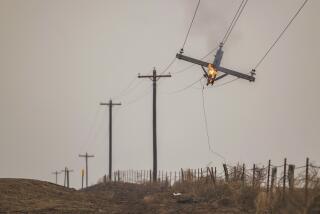Severe weather is in NASA scientists’ forecast
- Share via
WASHINGTON — As the world warms, the United States will face more severe thunderstorms with deadly lightning, damaging hail and the potential for stronger tornadoes, a study by NASA scientists suggests.
While other research has warned of large-scale weather changes, such as more extreme hurricanes and droughts, the new study predicts that even smaller events like thunderstorms will be more dangerous because of global warming.
The basic ingredients for severe U.S. inland storms are likely to be more plentiful in a warmer, moister world, said lead author Tony Del Genio, a NASA research scientist.
“The strongest thunderstorms, the strongest severe storms and tornadoes are likely to happen more often and be stronger,” Del Genio said Thursday at his office at the Goddard Institute for Space Studies in New York. The paper he co-wrote was published online in the journal Geophysical Research Letters.
Other scientists caution that this area of climate research is too difficult and new for this study to be definitive. But some upcoming studies also point in the same direction.
With a computer model, Del Genio explored an area that most climate scientists have avoided. Simple thunderstorms are too small for the massive models of the world’s climate. So Del Genio looked at the forces that combine to make thunderstorms.
A unique combination of geography and weather patterns already makes the United States the world’s hottest spot for tornadoes and severe storms in spring and summer. The large land mass that warms on hot days, the contours of the atmosphere’s jet stream, the wind coming off the Rocky Mountains and warm moist air coming up from the Gulf of Mexico all combine.
Del Genio’s computer model shows global warming will cause more strong updrafts, which occur when the wind moves up and down instead of sideways.
“The consequences of stronger updrafts are more lightning and bigger hail,” he said.
On a normal sunny day, updrafts are less than 1 mph. In a big rainstorm, they’re about 2 mph. In a severe storm they could be 20 to 30 mph. The faster that updraft, the worse the storms.
The Southeast and Midwest lie in the path of most of the worst of these storms.
However, the new study also forecasts danger for the Western United States. It predicts lightning will increase about 6% as the amount of carbon dioxide -- the chief global warming gas -- doubles.
Other pending and recent research, especially from the National Oceanic and Atmospheric Administration, point in the same general direction, said several scientists who weren’t involved in Del Genio’s study. But they pointed out that research in this area is so new that the NASA study is not the final word.
“It’s certainly a plausible result,” said Leo Donner, a climate modeling scientist at NOAA’s Geophysical Fluid Dynamics Laboratory in Princeton, N.J. Donner earlier this year came out with a study predicting more heavy rain as temperatures rise.
Harold Brooks, a top scientist at NOAA’s severe storms laboratory in Norman, Okla., has soon-to-be-published studies finding results similar to the new NASA study, especially when it comes to hail. Some of the severe hail that should be increasing could be baseball-size and come down at 100 mph, “falling like a major league fastball,” he said.






